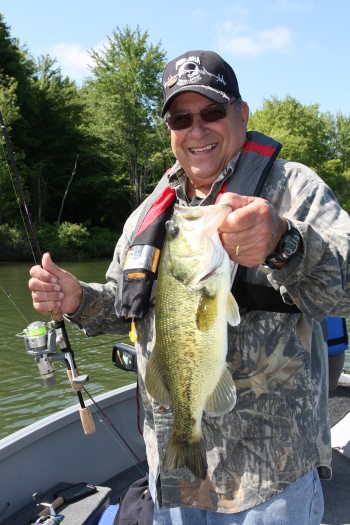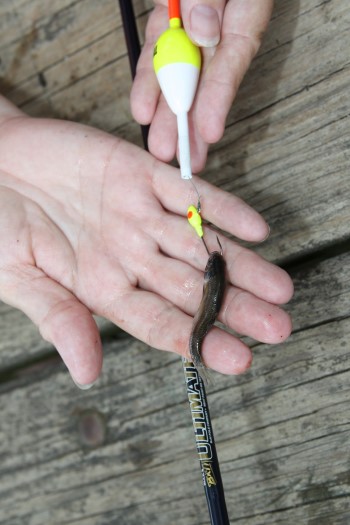 By Darl Black
By Darl Black
My wife and I really enjoy crappie fishing. It’s my second favorite species to fish for – right behind smallmouth bass. Actually in NW PA, there are probably more anglers interested in catching crappies than smallmouth bass. Why? Bass are caught-and-released. But ‘em crappies are kept and deep fried!
There are many excellent crappie lakes from New England, across the Great Lakes region and into the upper Mid-West. Although various forms of slow-trolling are very popular in the South, northern anglers typically limit their presentations to casting small crappie jigs, dropping baits around heavy cover, suspending a live minnow below a bobber, and drifting. These are presentations I routinely employ.
Having observed many everyday crappie anglers across the northern tier, many fishermen limit their rod arsenal to a single 5-1/2 or 6-foot ultralight or light-action rod to cover all their crappie fishing. However, no single all-purpose rod can be truly effective in every situation. Uniquely different presentations require rods of specific lengths and actions. This is something I demonstrate to my guide customers as we fish crappies with different presentations utilizing just three specific rods.
BnM specializes in crappie rods. To please crappie fishermen all over the country, they offer a wider variety of rod styles than this Yankee fishermen would ever need. But among the multitude of different rods, I’ve found three that are must-have to cover the most likely presentations for northern lakes.
Rod 1: Casting and retrieving small jigs. For swimming 1/16 and 1/8 jigs (as well as small spinners and micro crankbaits), BnM’s 7-foot Sam Heaton Super Sensitive (SHSS72) is an absolute gem. This rod has a moderate fast action (i.e. flexible through almost half the blank, but with backbone in the butt section) making it perfect for casting small baits with 4-pound Gamma Panfish Line. As the name says, it is remarkably sensitive. And for a light line rod, it easily handles the incidental bass, walleye and catfish we routinely catch.
Rod 2: Dipping thick cover with jigs. Shoreline deadfalls are potential crappie spots throughout the open water season. But we also dip emerging pad beds and reed beds in the late spring during the spawn and post spawn. This calls for a long rod with a flexible tip and strong back for lifting fish out of cover. BnM’s 10-foot Russ Bailey Signature Crappie Wizard Rod (CWRB102) is the ticket. I spool the reel with Gamma’s new Optic Yellow Panfish Line in six-pound test. Some anglers question my use a line with 6-pound diameter rating in pads, but the Gamma six-pound actually breaks at 12 pounds.
 Rod 3: Bobber rod & drift rod. You ask “What’s so special about a rod to fish a bobber and minnow?” Well it’s how I fish a bobber rig which requires a specific action. First the rig: I use a Thill Slip Float and a 1/24-ounce Bobby Garland Mo’Glo Jighead in place of a live bait hook; this puts all the weight near the bait for the cast. The cast: In the spring I often fire the bobber and minnow with a low trajectory lob under overhanging brush or willows, as well as into openings among the limbs of shoreline deadfalls. This requires a reasonably long powerful rod with a moderate taper so it loads properly for the cast. I’ve experimented with several rods before settling on Buck’s 8-foot Ultimate Super Stiff Rod (BULT82). BnM calls it Super Stiff, but it’s not stiff by bass rod standards! This same 8-foot rod doubles as a summer drift rod, too, for dragging Road Runner Heads with Bobby Garland Swimming Minnows.
Rod 3: Bobber rod & drift rod. You ask “What’s so special about a rod to fish a bobber and minnow?” Well it’s how I fish a bobber rig which requires a specific action. First the rig: I use a Thill Slip Float and a 1/24-ounce Bobby Garland Mo’Glo Jighead in place of a live bait hook; this puts all the weight near the bait for the cast. The cast: In the spring I often fire the bobber and minnow with a low trajectory lob under overhanging brush or willows, as well as into openings among the limbs of shoreline deadfalls. This requires a reasonably long powerful rod with a moderate taper so it loads properly for the cast. I’ve experimented with several rods before settling on Buck’s 8-foot Ultimate Super Stiff Rod (BULT82). BnM calls it Super Stiff, but it’s not stiff by bass rod standards! This same 8-foot rod doubles as a summer drift rod, too, for dragging Road Runner Heads with Bobby Garland Swimming Minnows.
There you have it. Three reasonably priced rods to cover 90% of what northern crappie anglers do. Go to www.BnMFishing.com to check them out.


